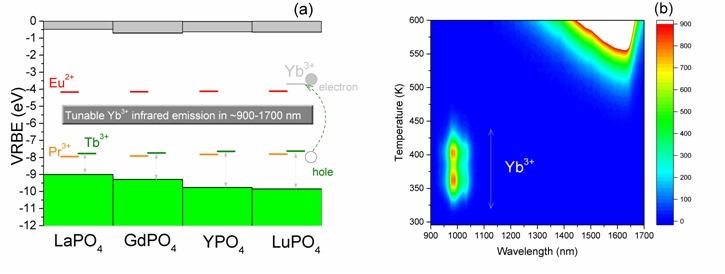博文
VRBE预测的可控Yb3+长余辉的设计
|||
title:
Charge carrier trapping processes in lanthanide doped La-, Gd-, Y-, and LuPO4
文章链接:http://pubs.rsc.org/en/Content/ArticleLanding/2017/TC/C7TC05221A#!divAbstract
Abstract
Various methods for deliberate design electron and hole trapping materials are explored with a study on double lanthanide doped rare earth ortho phosphates. Cerium acts as recombination center while lanthanide codopants as electron trapping centers in LaPO4:0.005Ce3+,0.005Ln3+. The electron trap depth generated by lanthanide codopants can be tailored by the choice of lanthanide, and for fixed set of lanthanide dopants like in Gd1-xLaxPO4:0.005Ce3+,0.005Ho3+ solid solutions by changing x leading to conduction band (CB) engineering. Here, the electrons liberated from Ho2+ recombine through the conduction band at Ce4+ to yield Ce3+ 5d-4f emission. In contrast, samarium, europium and ytterbium are recombination centers, while Tb3+ and Pr3+ act as hole trapping centers in double lanthanide doped YPO4. For Tb3+ and Pr3+ codopants recombination is realized via hole release rather than the more common reported electron release. The holes recombine via the valence band with the electrons trapped at Yb2+, Sm2+, or Eu2+ to generate 4f-4f luminescence from Yb3+, Sm3+, or Eu3+. Lu3+ was introduced in YPO4 to tailor the valence band (VB) energy and to tune the hole trap depths of Tb3+ and Pr3+ in Y1-xLuxPO4:0.005Ln3+ solid solutions. Our results promote the deliberate design electron and hole trapping materials from deep understanding of trap level locations and on the transport and trapping processes of charge carriers.

Figure1 (a) Stacked VRBE diagram of REPO4 with the binding energy in theground states of Eu2+, Pr3+, and Tb3+. (b) TLemission (TLEM) spectrum for LaPO4:0.005Yb3+,0.005Tb3+.
https://blog.sciencenet.cn/blog-497509-1088887.html
上一篇:在单一基质玻璃中实现可见发射调谐的部分探索研究
下一篇:Bi3+吸引电子与空穴的双重作用
全部作者的其他最新博文
- • 如何利用镧系和铋离子实现陷阱中电子与空穴运动的管理:同时实现X-ray成像,防伪与力的存储
- • Bi3+长余辉发光材料及其在防伪和X射线成像方面的应用
- • 设计LiTaO3:Ln3+,Eu3+ (Ln = Tb or Pr)光存储材料及其在防伪和柔性X射线成像应用
- • 吕天帅Laser & Photonics Reviews: 多功能和高性能LiTaO3:Tb3+, Gd3+
- • 吕天帅Chemical Engineering Journal: LiTaO3:Ln3+,Eu3+光存储材料
- • 吕天帅Materials Chemistry Frontiers: LiLuGeO4:Bi3+,Ln3+光存储材料